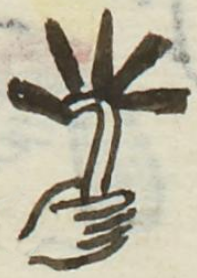Macuil (MH667r)
This black-line drawing of the compound glyph plus notation for the personal name Macuil (“Five”) is attested here as a man’s name. The glyph shows a hand (maitl) and a hand-held device (ma-), like a stick, on the top of which are five black lines spread out like fingers. This notation for the number five is attached to the top of the stick where it bends and turns to the viewer’s left.
Stephanie Wood
The result is a compound glyph, logographic and phonographic, because some of the parts contribute to the Ma- start to the name, and the notation adds the number five. Most likely, this name was originally a calendrical name, and there was a day name from the 260-day religious divinatory calendar (tonalpohualli) that once accompanied the number. This is one of the most popular number names in this entire collection, and it lives on in the present. See some additional examples below.
Stephanie Wood
1560
Jeff Haskett-Wood
cinco, mano, nombres de hombres

ma(itl), hand, https://nahuatl.wired-humanities.org/content/maitl
macuil(li), five, https://nahuatl.wired-humanities.org/content/macuilli
Cinco
Stephanie Wood
Matrícula de Huexotzinco, folio 667r, World Digital Library, https://www.loc.gov/resource/gdcwdl.wdl_15282/?sp=414&st=image.
This manuscript is hosted by the Library of Congress and the World Digital Library; used here with the Creative Commons, “Attribution-NonCommercial-ShareAlike 3.0 License” (CC-BY-NC-SAq 3.0).









